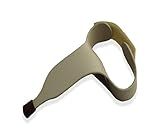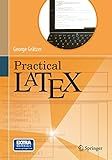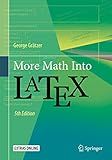Best Tools for Latex Typing to Buy in December 2025

Rehabilitation Advantage Left Handed Slip-On Keyboard Typing Assistance Tool, Small, Tan
- EFFORTLESS TYPING ON ANY KEYBOARD SIZE WITH COMFORT AND EASE.
- SLIP-RESISTANT RUBBER TIP ENSURES PRECISION ON EVERY KEYSTROKE.
- ERGONOMIC DESIGN MOLDS TO YOUR HAND FOR A PERFECT FIT.



Practical LaTeX



More Math Into LaTeX


In LaTeX, typing special letters often involves using specific commands or environments depending on the type of special character you want to include. For accented characters, you can use commands like \acute{}, \grave{}, \tilde{}, and \hat{}. For example, to type an accented 'e', you can use \'{e} to get é. Umlauts are represented using \"{}, such as \"{o} for ö. If you need math symbols, LaTeX offers a wealth of options; Greek letters like alpha and beta can be typed using \alpha and \beta, respectively. For special symbols like the degree sign, you may use ^\circ in math mode. Other special characters like the Euro sign can be input using \texteuro if you include packages like textcomp. If you want to insert arbitrary Unicode characters, the unicode-math or fontspec packages can be useful but require compiling with XeLaTeX or LuaLaTeX. Additionally, certain special characters may require escaping backslashes if they are also used in LaTeX commands, such as \% for the percent sign and \& for the ampersand.
How to type superscripts in LaTeX?
In LaTeX, superscripts are created using the caret symbol (^). You place the content you want to superscript inside curly braces {} following the caret. Here are a few examples:
- Single Character Superscript: To raise a single character into superscript, place that character immediately after the caret. For example, to create ( x^2 ), you type: x^2
- Multiple Characters Superscript: If the superscript consists of more than one character, you must enclose these characters in curly braces. For example, to write ( e^{x+y} ), you type: e^{x+y}
- Combined with Subscripts: You can use subscripts and superscripts together. For example, to write ( x_i^2 ), you type: x_i^2 And for something like ( x_{i,j}^{n+1} ), you type: x_{i,j}^{n+1}
- Using Math Mode: Superscripts are typically used in mathematical expressions, so remember to place them within math mode, either inline using dollar signs $ ... $, or in display mode using \[ ... \] or the equation environment. For instance: $x^2 + y^{n+1} = z$ or \[ x^2 + y^{n+1} = z \]
Using these methods, you can properly format superscripts in your LaTeX documents.
What is the way to type a bullet point in LaTeX?
In LaTeX, you can create bullet points using the itemize environment. Here is a basic example of how to use it:
\begin{itemize} \item First bullet point \item Second bullet point \item Third bullet point \end{itemize}
Each \item command within the itemize environment will produce a bullet point. If you want to customize the appearance of the bullet (using symbols other than the default), you might need additional packages or custom commands, but for standard bullet points, the itemize environment is the way to go.
What is the command for typing a prime symbol in LaTeX?
In LaTeX, you can type a prime symbol using the ^{\prime} command after a mathematical expression. For example, to denote ( f' ), you would write:
f^{\prime}
Alternatively, if you are using more complex expressions or want a shorthand method, you can also use the single quote character directly after variables inside a math environment, like this:
f'
Both methods will render the prime symbol in the output. The use of ^{\prime} can be preferable for consistency or clarity, especially in more complex mathematical expressions.
